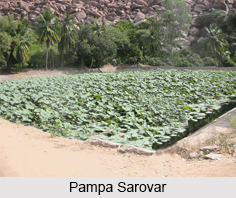 Pampa Sarovar is a lake that is situated in Koppal district near Hampi in the Indian state of Karnataka. It is also about a kilometre away from the foothills of Hanuman Temple and located to the south of the Tungabhadra River. The Pampa Sarovar is one of the five holy sarovars or lakes in India, Panch Sarovar, Mansarovar, Bindu Sarovar, Narayan Sarovar and Pushkar Sarovar.
Pampa Sarovar is a lake that is situated in Koppal district near Hampi in the Indian state of Karnataka. It is also about a kilometre away from the foothills of Hanuman Temple and located to the south of the Tungabhadra River. The Pampa Sarovar is one of the five holy sarovars or lakes in India, Panch Sarovar, Mansarovar, Bindu Sarovar, Narayan Sarovar and Pushkar Sarovar.
Legend of Pampa Sarovar
Pampa Sarovar, in Hindu mythology, is regarded as the place where Pampa, a form of Lord Shiva`s consort Parvati, performed penance to show her devotion to Lord Shiva. It is also one of the Sarovars that finds a mention in the Hindu epic, Ramayana as the place where Shabhari, a devotee of Lord Rama waited for the arrival of Rama.
According to the legend, Shabari, a pious devotee of Rama, faithfully prayed daily to see the Lord. She resided in the ashram of Matunga, her guru. The place is now known as "Matunga Parvat", in Hampi. Before her guru Matunga Rishi died, he blessed her so she would certainly see Rama. After his death, Shabari continued to live in the ashram awaiting Rama. Many years passed by and Shabari became an old woman, before Lord Rama stopped at the ashram on his journey to Lanka. She proceeded to feed Rama and his brother Lakshmana. Touched by her piety Lord Rama and Lakshmana bowed down at her feet. Then, they narrated to her the incident of Sita`s kidnapping and Shabari suggested that they seek help from Hanuman and Sugriva of the monkey kingdom who lived further south near the Pampa Lake.
Pampa Sarovar is also famous for the pushti marg vaishnavas, where Srimad Vallabhacahrya had performed Srimad Bhawwad in the 16th century and its mention in many bharat darshan visits, also reaffirms the importance of the holy place.
Overview of Pampa Sarovar
Filled with lotuses, the Pampa Sarovar is extremely picturesque when the flowers are in bloom. The lake is located in a hidden valley among the hills on route from Anegundi to Hospet. Facing the pond, there is a Lakshmi temple, as well as a Shiva temple and next to the sarovar, under a mango tree stands a small Ganesh shrine.
Visiting Information on Pampa Sarovar
The nearest railway station is at Koppal at a distance of about 43 km from the sarovar and the Baldota Koppal Aerodrome is the closest airport at a distance of 50 km from the Pampa Sarovar.



















